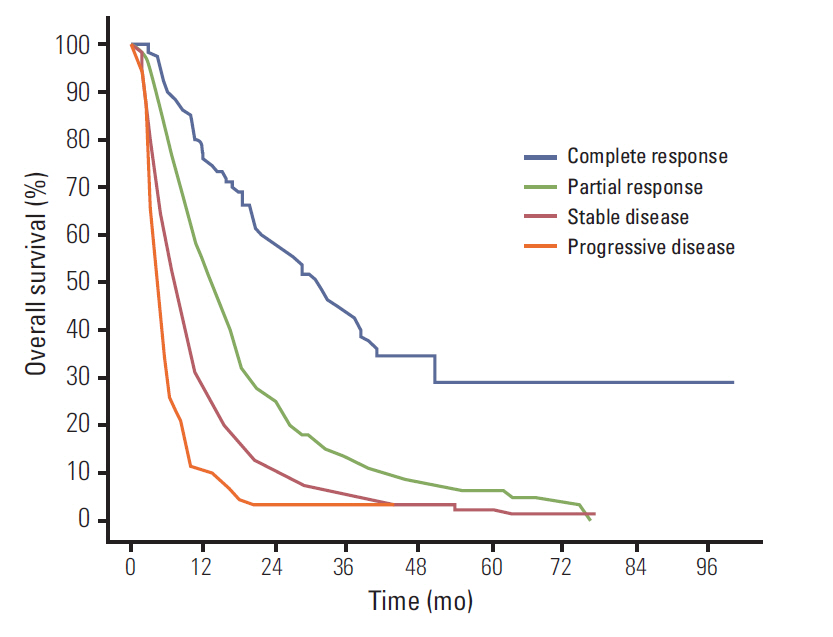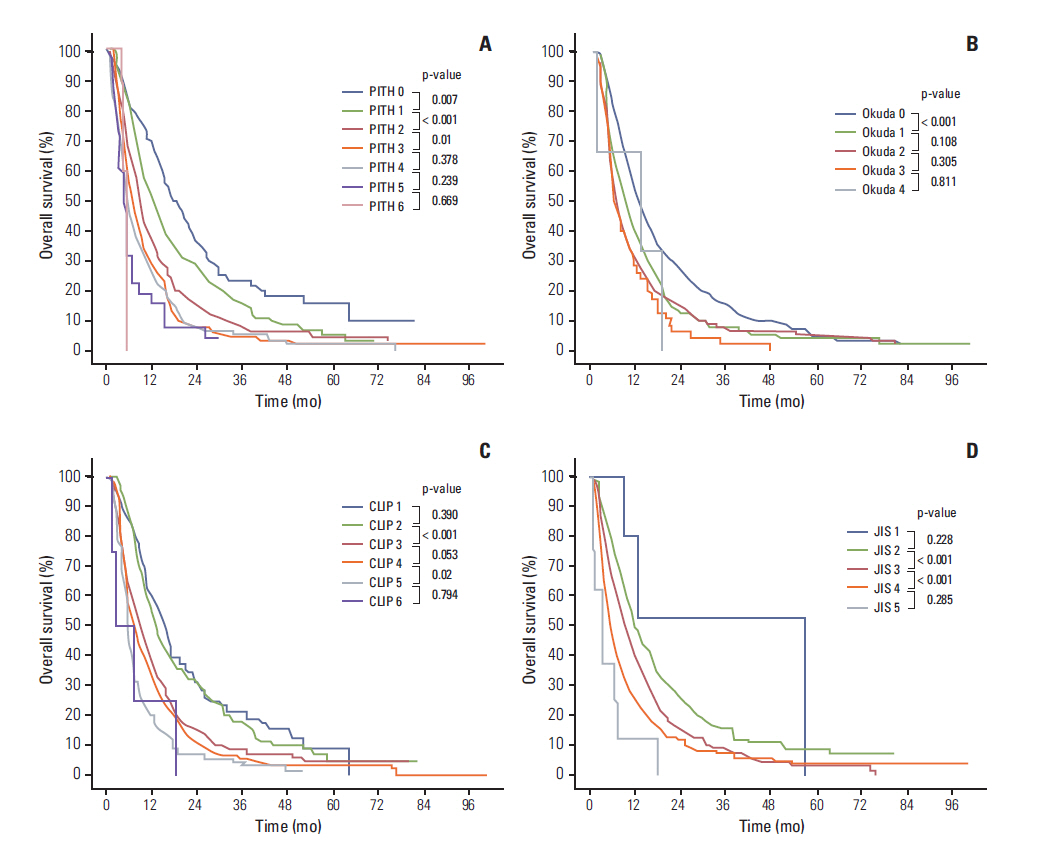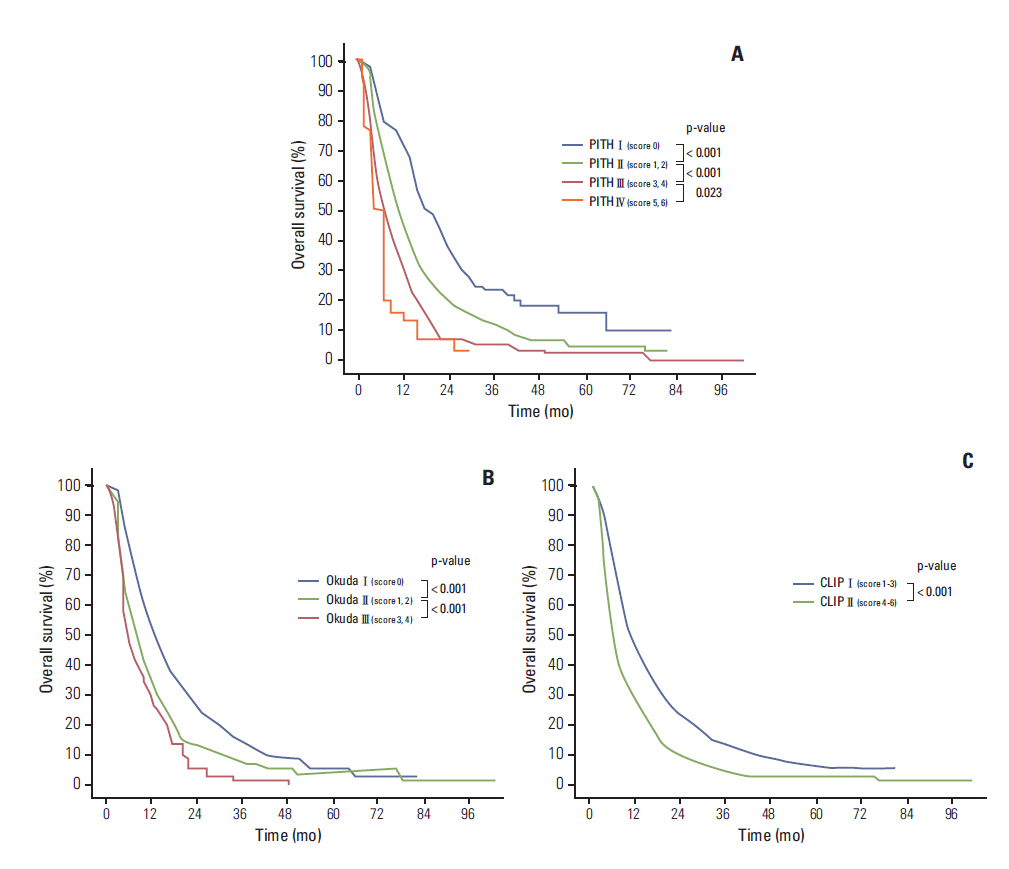Cancer Res Treat.
2014 Oct;46(4):348-357. 10.4143/crt.2013.142.
Multicenter Validation Study of a Prognostic Index for Portal Vein Tumor Thrombosis in Hepatocellular Carcinoma
- Affiliations
-
- 1Department of Radiation Oncology, Samsung Medical Center, Sungkyunkwan University School of Medicine, Seoul, Korea. hee.ro.park@samsung.com
- 2Department of Radiation Oncology, Asan Medical Center, University of Ulsan College of Medicine, Seoul, Korea.
- 3Research Institute and Hospital, National Cancer Center, Goyang, Korea.
- 4Department of Radiation Oncology, Yonsei University College of Medicine, Seoul, Korea.
- 5Department of Radiation Oncology, The Catholic University of Korea College of Medicine, Seoul, Korea.
- 6Department of Radiation Oncology, Incheon St. Mary Hospital, The Catholic University of Korea College of Medicine, Incheon, Korea.
- 7Department of Radiation Oncology, Korea University College of Medicine, Seoul, Korea.
- 8Department of Radiation Oncology, Seoul National University College of Medicine, Seoul, Korea.
- 9Department of Radiation Oncology, Keimyung University Dongsan Medical Center, Keimyung University School of Medicine, Daegu, Korea.
- 10Department of Radiation Oncology, Korea Institute of Radiological and Medical Sciences, Seoul, Korea.
- 11Department of Radiation Oncology, Dong-A University College of Medicine, Busan, Korea.
- KMID: 2380372
- DOI: http://doi.org/10.4143/crt.2013.142
Abstract
- PURPOSE
We previously reported on a staging system and prognostic index (PITH) for portal vein tumor thrombosis (PVTT) in hepatocellular carcinoma (HCC) patients treated with radiotherapy (RT) at a single institution. The aim of this study is to validate the PITH staging system using data from patients at other institutions and to compare it with other published staging systems.
MATERIALS AND METHODS
A total of 994 HCC patients with PVTT who were treated with RT between 1998 and 2011 by the Korean Radiation Oncology Group were analyzed retrospectively. All patients were staged using the Cancer of the Liver Italian Program (CLIP), Japanese Integrated Staging (JIS), Okuda, and PITH staging systems, and survival data were analyzed. The likelihood ratio, Akaike information criteria (AIC), time-dependent receiver operating characteristics, and prediction error curve analysis were used to determine discriminatory ability for comparison of staging systems.
RESULTS
The median survival was 9.2 months. Compared with the other staging systems, the PITH score gave the highest values for likelihood ratio and lowest AIC values, demonstrating that PITH may be a better prognostic model. Although the values were not significant and differences were not exceptional, the PITH score showed slightly better performance with respect to time-dependent area under curve and integrated Brier score of prediction error curve.
CONCLUSION
The PITH staging system was validated in this multicenter retrospective study and showed better stratification ability in HCC patients with PVTT than other systems.
MeSH Terms
Figure
Cited by 1 articles
-
2018 Korean Liver Cancer Association–National Cancer Center Korea Practice Guidelines for the Management of Hepatocellular Carcinoma
,
Korean J Radiol. 2019;20(7):1042-1113. doi: 10.3348/kjr.2019.0140.
Reference
-
References
1. A new prognostic system for hepatocellular carcinoma: a retrospective study of 435 patients: the Cancer of the Liver Italian Program (CLIP) investigators. Hepatology. 1998; 28:751–5.2. Carr BI, Pancoska P, Branch RA. Tumor and liver determinants of prognosis in unresectable hepatocellular carcinoma: a large case cohort study. Hepatol Int. 2010; 4:396–405.
Article3. Llovet JM, Bustamante J, Castells A, Vilana R, Ayuso Mdel C, Sala M, et al. Natural history of untreated nonsurgical hepatocellular carcinoma: rationale for the design and evaluation of therapeutic trials. Hepatology. 1999; 29:62–7.
Article4. Kudo M, Chung H, Osaki Y. Prognostic staging system for hepatocellular carcinoma (CLIP score): its value and limitations, and a proposal for a new staging system, the Japan Integrated Staging Score (JIS score). J Gastroenterol. 2003; 38:207–15.
Article5. Leung TW, Tang AM, Zee B, Lau WY, Lai PB, Leung KL, et al. Construction of the Chinese University Prognostic Index for hepatocellular carcinoma and comparison with the TNM staging system, the Okuda staging system, and the Cancer of the Liver Italian Program staging system: a study based on 926 patients. Cancer. 2002; 94:1760–9.6. Llovet JM, Bru C, Bruix J. Prognosis of hepatocellular carcinoma: the BCLC staging classification. Semin Liver Dis. 1999; 19:329–38.
Article7. Okuda K, Ohtsuki T, Obata H, Tomimatsu M, Okazaki N, Hasegawa H, et al. Natural history of hepatocellular carcinoma and prognosis in relation to treatment: study of 850 patients. Cancer. 1985; 56:918–28.
Article8. Katamura Y, Aikata H, Takaki S, Azakami T, Kawaoka T, Waki K, et al. Intra-arterial 5-fluorouracil/interferon combination therapy for advanced hepatocellular carcinoma with or without three-dimensional conformal radiotherapy for portal vein tumor thrombosis. J Gastroenterol. 2009; 44:492–502.
Article9. Peng ZW, Guo RP, Zhang YJ, Lin XJ, Chen MS, Lau WY. Hepatic resection versus transcatheter arterial chemoembolization for the treatment of hepatocellular carcinoma with portal vein tumor thrombus. Cancer. 2012; 118:4725–36.
Article10. Yoon SM, Lim YS, Won HJ, Kim JH, Kim KM, Lee HC, et al. Radiotherapy plus transarterial chemoembolization for hepatocellular carcinoma invading the portal vein: long-term patient outcomes. Int J Radiat Oncol Biol Phys. 2012; 82:2004–11.
Article11. Yu JI, Park HC, Lim DH, Park W, Yoo BC, Paik SW, et al. Prognostic index for portal vein tumor thrombosis in patients with hepatocellular carcinoma treated with radiation therapy. J Korean Med Sci. 2011; 26:1014–22.
Article12. Lencioni R, Llovet JM. Modified RECIST (mRECIST) assessment for hepatocellular carcinoma. Semin Liver Dis. 2010; 30:52–60.
Article13. Akaike H. A new look at statistical model identification. IEEE Trans Automat Contr. 1974; 19:716–23.14. Gerds TA, Schumacher M. Efron-type measures of prediction error for survival analysis. Biometrics. 2007; 63:1283–7.
Article15. Heagerty PJ, Zheng Y. Survival model predictive accuracy and ROC curves. Biometrics. 2005; 61:92–105.
Article16. Henderson JM, Sherman M, Tavill A, Abecassis M, Chejfec G, Gramlich T. AHPBA/AJCC consensus conference on staging of hepatocellular carcinoma: consensus statement. HPB (Oxford). 2003; 5:243–50.
Article17. Inarrairaegui M, Thurston KG, Bilbao JI, D'Avola D, Rodriguez M, Arbizu J, et al. Radioembolization with use of yttrium-90 resin microspheres in patients with hepatocellular carcinoma and portal vein thrombosis. J Vasc Interv Radiol. 2010; 21:1205–12.18. Kasai K, Ushio A, Kasai Y, Sawara K, Miyamoto Y, Oikawa K, et al. Combination therapy of intra-arterial 5-fluorouracil and systemic pegylated interferon alpha-2b for advanced hepatocellular carcinoma. Int J Clin Oncol. 2011; 16:221–9.19. Bruix J, Sherman M; American Association for the Study of Liver Diseases. Management of hepatocellular carcinoma: an update. Hepatology. 2011; 53:1020–2.
Article20. Cheng AL, Kang YK, Chen Z, Tsao CJ, Qin S, Kim JS, et al. Efficacy and safety of sorafenib in patients in the Asia-Pacific region with advanced hepatocellular carcinoma: a phase III randomised, double-blind, placebo-controlled trial. Lancet Oncol. 2009; 10:25–34.
Article21. Llovet JM, Ricci S, Mazzaferro V, Hilgard P, Gane E, Blanc JF, et al. Sorafenib in advanced hepatocellular carcinoma. N Engl J Med. 2008; 359:378–90.
Article22. Burgmans MC, Irani FG, Chan WY, Teo TK, Kao YH, Goh AS, et al. Radioembolization after portal vein embolization in a patient with multifocal hepatocellular carcinoma. Cardiovasc Intervent Radiol. 2012; 35:1519–23.
Article23. Zeng ZC, Fan J, Tang ZY, Zhou J, Qin LX, Wang JH, et al. A comparison of treatment combinations with and without radiotherapy for hepatocellular carcinoma with portal vein and/or inferior vena cava tumor thrombus. Int J Radiat Oncol Biol Phys. 2005; 61:432–43.
Article24. Kim DY, Park W, Lim DH, Lee JH, Yoo BC, Paik SW, et al. Three-dimensional conformal radiotherapy for portal vein thrombosis of hepatocellular carcinoma. Cancer. 2005; 103:2419–26.
Article25. Meng MB, Cui YL, Lu Y, She B, Chen Y, Guan YS, et al. Transcatheter arterial chemoembolization in combination with radiotherapy for unresectable hepatocellular carcinoma: a systematic review and meta-analysis. Radiother Oncol. 2009; 92:184–94.
Article
- Full Text Links
- Actions
-
Cited
- CITED
-
- Close
- Share
- Similar articles
-
- Clinical features of portal vein thrombosis in hepatocellular carcinoma
- Reappraisal of transarterial radioembolization for liver-confined hepatocellular carcinoma with portal vein tumor thrombosis: Editorial on “Transarterial radioembolization versus tyrosine kinase inhibitor in hepatocellular carcinoma with portal vein thrombosis”
- Sonographic features of portal vein thrombosis
- Liver transplantation for hepatocellular carcinoma with portal vein tumor thrombosis
- A Case of Hepatocellular Carcinoma with Portal Vein Tumor Thrombosis Treated by Hepatic Artery Injection Chemotherapy and Radiotherapy




